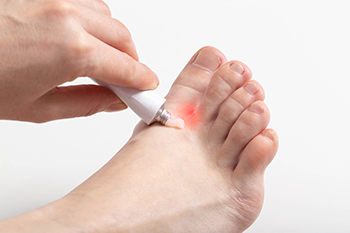
Athlete's foot, medically known as tinea pedis, is a common fungal infection that affects the skin of the feet, particularly between the toes. It's caused by various types of fungi, including trichophyton and epidermophyton, which thrive in warm, damp environments such as sweaty socks or tight shoes. Athlete's foot often starts with itching and burning sensations, followed by red, flaky, or scaly skin, and sometimes is accompanied by blisters and a foul odor. To prevent athlete's foot, it is important to maintain exceptional foot health. Wash and thoroughly dry your feet daily, ensuring the spaces between your toes are clean and dry. Changing socks frequently, especially after physical activities, can also help. Opt for breathable footwear and avoid walking barefoot in public areas like locker rooms or swimming pools. By incorporating these practices into your routine, you can combat and prevent athlete's foot, maintaining healthy and happy feet. If you have developed athlete’s foot, it is strongly suggested that you are under the care of a podiatrist who can prescribe the right course of treatment for you.
Athlete’s Foot
Athlete’s foot is often an uncomfortable condition to experience. Thankfully, podiatrists specialize in treating athlete’s foot and offer the best treatment options. If you have any questions about athlete’s foot, consult with Dr. John Branwell from Kearny, New Jersey. Our doctor will assess your condition and provide you with quality treatment.
What Is Athlete’s Foot?
Tinea pedis, more commonly known as athlete’s foot, is a non-serious and common fungal infection of the foot. Athlete’s foot is contagious and can be contracted by touching someone who has it or infected surfaces. The most common places contaminated by it are public showers, locker rooms, and swimming pools. Once contracted, it grows on feet that are left inside moist, dark, and warm shoes and socks.
Prevention
The most effective ways to prevent athlete’s foot include:
- Thoroughly washing and drying feet
- Avoid going barefoot in locker rooms and public showers
- Using shower shoes in public showers
- Wearing socks that allow the feet to breathe
- Changing socks and shoes frequently if you sweat a lot
Symptoms
Athlete’s foot initially occurs as a rash between the toes. However, if left undiagnosed, it can spread to the sides and bottom of the feet, toenails, and if touched by hand, the hands themselves. Symptoms include:
- Redness
- Burning
- Itching
- Scaly and peeling skin
Diagnosis and Treatment
Diagnosis is quick and easy. Skin samples will be taken and either viewed under a microscope or sent to a lab for testing. Sometimes, a podiatrist can diagnose it based on simply looking at it. Once confirmed, treatment options include oral and topical antifungal medications.
If you have any questions, please feel free to contact our office located in Kearny, NJ . We offer the newest diagnostic and treatment technologies for all your foot care needs.
